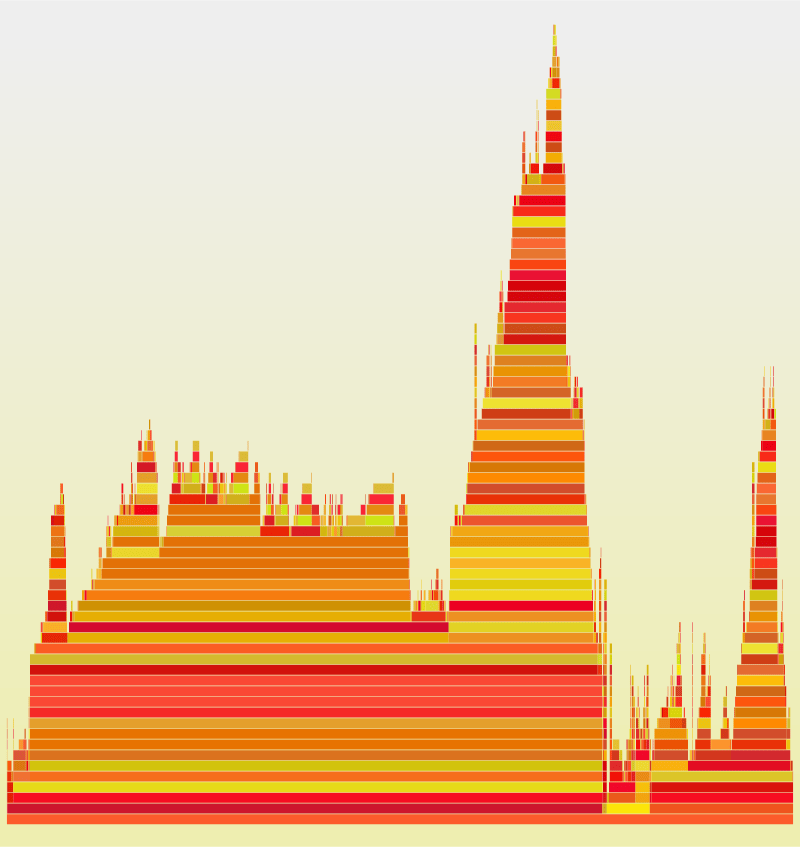57 releases
| 0.12.2 | Mar 22, 2025 |
|---|---|
| 0.12.0 | Nov 19, 2024 |
| 0.11.20 | Jul 14, 2024 |
| 0.11.19 | Nov 25, 2023 |
| 0.6.0 | Mar 13, 2019 |
#3 in Profiling
1,094,378 downloads per month
Used in 310 crates
(38 directly)
355KB
7K
SLoC
Inferno is a port of parts of the flamegraph
toolkit to Rust, with the
aim of improving the performance of the original flamegraph tools. The
primary focus is on speeding up the stackcollapse-* tools that process
output from various profiling tools into the "folded" format expected by
the flamegraph plotting tool. So far, the focus has been on parsing
profiling results from
perf and
DTrace. At the time of writing,
inferno-collapse-perf is ~20x faster than stackcollapse-perf.pl and
inferno-collapse-dtrace is ~20x faster than stackcollapse.pl (see
compare.sh).
It is developed in part through live coding sessions, which you can find on YouTube.
Using Inferno
As a library
Inferno provides a library interface through
the inferno crate. This will let you collapse stacks and produce flame
graphs without going through the command line, and is intended for
integration with external Rust tools like cargo-flamegraph.
As a binary
First of all, you may want to look into cargo flamegraph, which deals with much of the infrastructure for you!
If you want to use Inferno directly, then build your application in release mode and with debug symbols, and then run a profiler to gather profiling data. Once you have the data, pass it through the appropriate Inferno "collapser". Depending on your platform, this will look something like
$ # Linux
# perf record --call-graph dwarf target/release/mybin
$ perf script | inferno-collapse-perf > stacks.folded
or
$ # macOS
$ target/release/mybin &
$ pid=$!
# dtrace -x ustackframes=100 -n "profile-97 /pid == $pid/ { @[ustack()] = count(); } tick-60s { exit(0); }" -o out.user_stacks
$ cat out.user_stacks | inferno-collapse-dtrace > stacks.folded
You can also use inferno-collapse-guess which should work on both
perf and DTrace samples. In the end, you'll end up with a "folded stack"
file. You can pass that file to inferno-flamegraph to generate a flame
graph SVG:
$ cat stacks.folded | inferno-flamegraph > flamegraph.svg
You'll end up with an image like this:
Obtaining profiling data
To profile your application, you'll need to have a "profiler" installed.
This will likely be perf or bpftrace on Linux, and [DTrace] on
macOS. There are some great instructions on how to get started with
these tools on Brendan Gregg's [CPU Flame Graphs page].
[profiler]: https://en.wikipedia.org/wiki/Profiling_(computer_programming
perf: https://perf.wiki.kernel.org/index.php/Main_Page
bpftrace: https://github.com/iovisor/bpftrace/
[DTrace]: https://www.joyent.com/dtrace
[CPU Flame Graphs page]: http://www.brendangregg.com/FlameGraphs/cpuflamegraphs.html#Instructions
On Linux, you may need to tweak a kernel config such as
$ echo 0 | sudo tee /proc/sys/kernel/perf_event_paranoid
to get profiling to work.
Performance
Comparison to the Perl implementation
To run Inferno's performance comparison, run ./compare.sh.
It requires hyperfine, and you
must make sure you also check out Inferno's
submodules.
In general, Inferno's perf and dtrace collapsers are ~20x faster than
stackcollapse-*, and the sample collapser is ~10x faster.
Benchmarks
Inferno includes criterion
benchmarks in benches/. Criterion saves its results in
target/criterion/, and uses that to recognize changes in performance,
which should make it easy to detect performance regressions while
developing bugfixes and improvements.
You can run the benchmarks with cargo bench. Some results (YMMV):
My desktop computer (AMD Ryzen 5 2600X) gets (/N means N cores):
collapse/dtrace/1 time: [8.2767 ms 8.2817 ms 8.2878 ms]
thrpt: [159.08 MiB/s 159.20 MiB/s 159.29 MiB/s]
collapse/dtrace/12 time: [3.8631 ms 3.8819 ms 3.9019 ms]
thrpt: [337.89 MiB/s 339.63 MiB/s 341.28 MiB/s]
collapse/perf/1 time: [16.386 ms 16.401 ms 16.416 ms]
thrpt: [182.37 MiB/s 182.53 MiB/s 182.70 MiB/s]
collapse/perf/12 time: [4.8056 ms 4.8254 ms 4.8460 ms]
thrpt: [617.78 MiB/s 620.41 MiB/s 622.97 MiB/s]
collapse/sample time: [8.9132 ms 8.9196 ms 8.9264 ms]
thrpt: [155.49 MiB/s 155.61 MiB/s 155.72 MiB/s]
flamegraph time: [16.071 ms 16.118 ms 16.215 ms]
thrpt: [38.022 MiB/s 38.250 MiB/s 38.363 MiB/s]
My laptop (Intel Core i7-8650U) gets:
collapse/dtrace/1 time: [8.3612 ms 8.3839 ms 8.4114 ms]
thrpt: [156.74 MiB/s 157.25 MiB/s 157.68 MiB/s]
collapse/dtrace/8 time: [3.4623 ms 3.4826 ms 3.5014 ms]
thrpt: [376.54 MiB/s 378.58 MiB/s 380.79 MiB/s]
collapse/perf/1 time: [15.723 ms 15.756 ms 15.798 ms]
thrpt: [189.51 MiB/s 190.01 MiB/s 190.41 MiB/s]
collapse/perf/8 time: [6.1391 ms 6.1554 ms 6.1715 ms]
thrpt: [485.09 MiB/s 486.36 MiB/s 487.65 MiB/s]
collapse/sample time: [9.3194 ms 9.3429 ms 9.3719 ms]
thrpt: [148.10 MiB/s 148.56 MiB/s 148.94 MiB/s]
flamegraph time: [16.490 ms 16.503 ms 16.518 ms]
thrpt: [37.324 MiB/s 37.358 MiB/s 37.388 MiB/s]
License
Inferno is a port of @brendangregg's awesome original FlameGraph project, written in Perl, and owes its existence and pretty much of all of its functionality entirely to that project. Like FlameGraph, Inferno is licensed under the CDDL 1.0 to avoid any licensing issues. Specifically, the CDDL 1.0 grants
a world-wide, royalty-free, non-exclusive license under intellectual property rights (other than patent or trademark) Licensable by Initial Developer, to use, reproduce, modify, display, perform, sublicense and distribute the Original Software (or portions thereof), with or without Modifications, and/or as part of a Larger Work; and under Patent Claims infringed by the making, using or selling of Original Software, to make, have made, use, practice, sell, and offer for sale, and/or otherwise dispose of the Original Software (or portions thereof).
as long as the source is made available along with the license (3.1), both of which are true since you're reading this file!
Dependencies
~2.6–9MB
~68K SLoC
